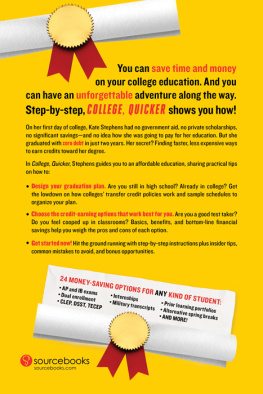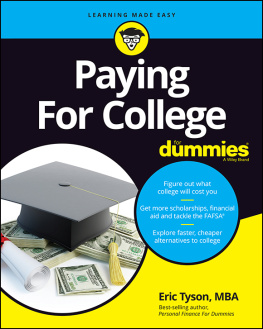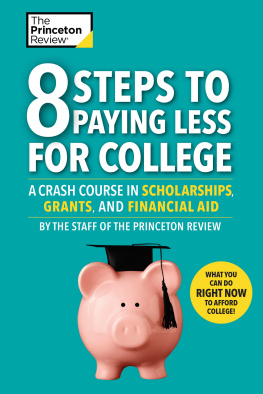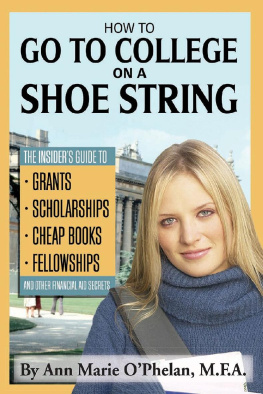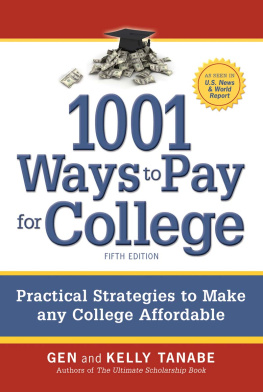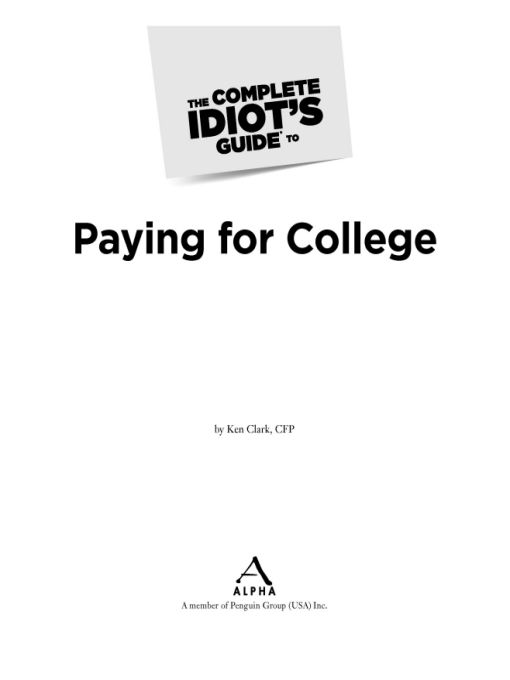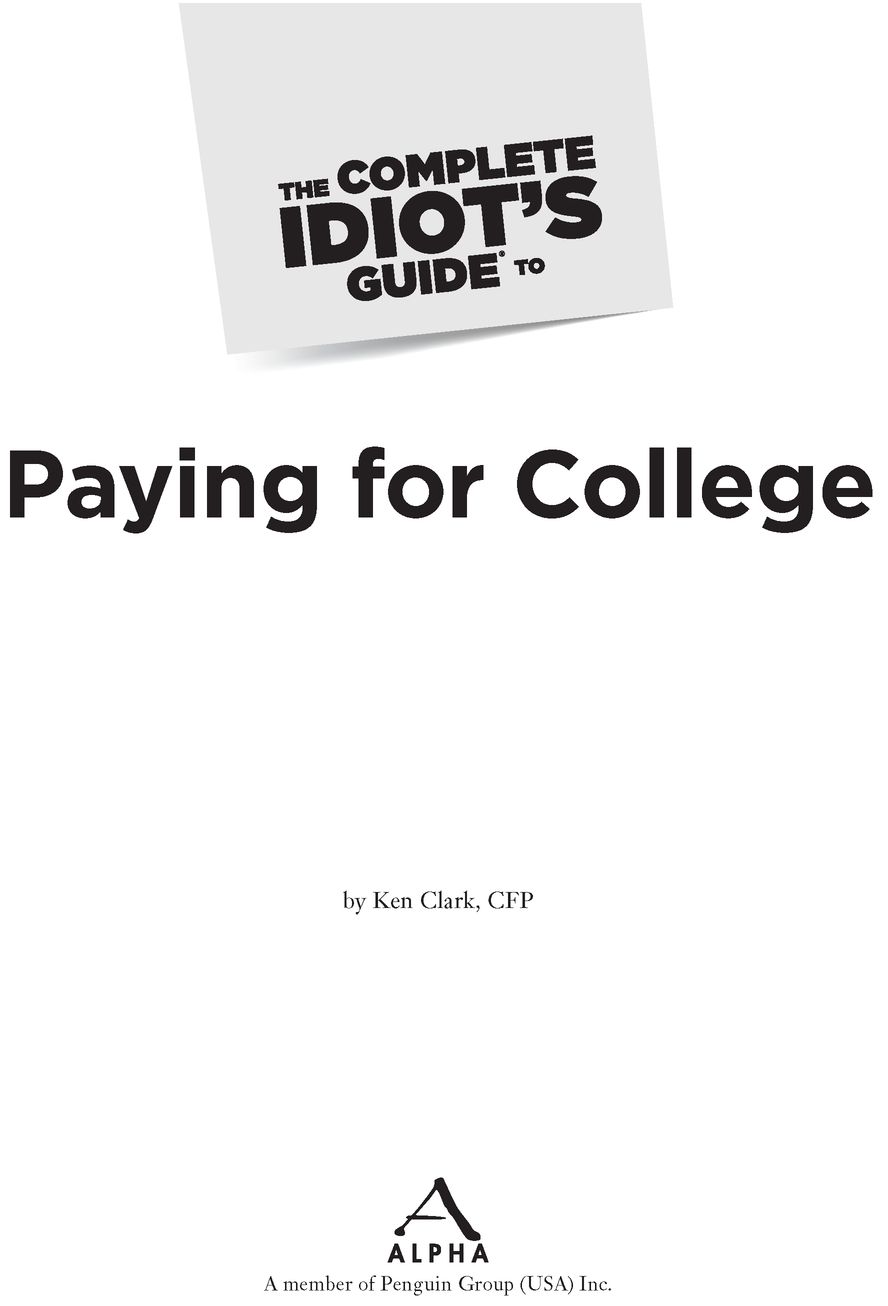Table of Contents
To everyone fighting an uphill battle to educate themselves or someone elseits worth it!
Introduction
Titanic was meant to be the ocean liner by which all others were measured. Not only did it represent the height of seagoing luxury for its day, but its designers also believed that its seaworthiness was unparalleled. In short, this masterpiece of planning, design, and execution was believed to be unsinkable. Of course, it only took one oversized chunk of ice to prove that theory catastrophically wrong.
During my years as a financial planner, Ive seen few things sink as many households finances as the failure to be strategic in planning and paying for a college education. Some fail to plan for their own educational expenses, which results in iceberg-size student loans they spend decades paying off. Others fail to plan for their childrens costs, which ends up ripping a gaping hole in their otherwise impervious retirement plans. Tragically, some fail to plan for both, which leaves them treading financial water for the rest of their lives.
Of course, many of these households attempted to be responsible, socking away money for future costs. But by the time college was actually in sight, they realized that it was not going to be nearly enough. Between sky-rocketing tuition, underperforming investments, and a lousy economy, they realized too late that there was not enough time to play catch-up. Unfortunately, they also lacked the skills and knowledge to take evasive and creative maneuvers to help them dodge impending financial doom.
That brings me to what this book is meant to be: a captains manual to guiding your finances safely through the financially treacherous waters of the college experience. More than anything else, it is designed to helping current students and their families do some last-minute maneuvering to avoid ending up on the rocks or going down with the ship.
How to Use This Book
Youll find all the best need-to-know information conveniently arranged into five parts. While I think youd do yourself a favor if you read this guide from start to finish, youre free to jump around (heck, its your book). If you have a burning need for knowledge in a certain area, feel free to flip straight to that section.
Part 1, Getting a Grip on College Costs, gives you a buffet of tips and tricks that savvy students are using to lower the real costs associated with attending school. Not only will we put things like tuition, room, and board under the microscope, but well also dissect hidden costs such as travel and medical expenses. Well round out this part by taking a look at how to tap your savings wisely to minimize taxes and penalties. By the end of this section, its very possible that youll have lowered the cost of a year of college by anywhere from 10 to 50 percent.
Part 2, Strategies for Borrowing, takes the mystery out of borrowing and repaying student loans. Considering that borrowing might be a nonnegotiable fact for many who cannot or will not compromise on where they get their education, mastering the lending lifelines and loopholes is essential. Not only will these chapters touch on which programs you should consider and tips for maximizing your loan package, but well also cover legal ways to reduce or even eliminate your repayment period.
Part 3, Free Money for College, covers some of the best, as well as some of the least-known, programs for getting a free education. Chances are, between the scholarships, grants, tax breaks, and free tuition programs covered in this part, youll be paying a lot less than most people attending the same school.
Part 4, Best-Kept Funding Secrets, will give you an insiders guide to some of the most overlooked sources for college funds. Its not uncommon for parents or students utilizing one or more of these programs to pay little or nothing for a college degree. Of course, because these programs require a student or his parent to hustle a bit more than just filling out a scholarship application, well give you the inside track on exactly what you need to do to make these programs work for you.
Part 5, Thinking Outside the Box, rounds out the book by examining the logic behind some radical approaches to a college education. Well take a look at the financial merit of nontraditional and online educations, utilizing community colleges to save tens of thousands of dollars, some of the biggest mistakes typical parents or students make, and the merits of putting your kids to work to help diffuse the cost.
Ive also included six appendixes to give you everything you need on a practical level to put the advice contained in this book into action. Youll find a Glossary that defines unfamiliar words and terms; a College Cash Strategy Worksheet on which to track your progress as you work your way through the chapters; a helpful list of resources to pursue different funding opportunities; a directory of financial aid programs organized by state; a list of my favorite scholarship programs with their contact info; and a state-by-state list of Section 529 plans.
Bonus Features
Kind of like a tutor who helps ensure that you pass your calculus exam, this book comes with some built-in extras. These sidebars give you definitions as well as cautions and pointers that are immediately usable in your attempt to pay for college:
DEFINITION
Like a first-year freshman in Latin 101, the language of college funding can give you a panic attack. To keep you from feeling like a dunce, Ive included some basic definitions of the terms that trip most people up.
CHEAT SHEET
Youve only got one chance to pass the college funding test, so Ive included these must know tidbits that will keep your finances on the honor roll.
FLUNK-PROOF FINANCES
There are some common mistakes that can set you back a pretty penny. Pay close attention to these warnings and red flags to avoid getting tripped up.
WORLD WIDE WISDOM
These resources from the Web and other experts can help ensure that you ace one of lifes biggest financial tests.
Acknowledgments
As always, Id like to thank my amazingly patient and wise editors at Penguin/Alpha Books, Randy Ladenheim-Gil and Lynn Northrup.
To my agent, Bob Diforio at D4EO Literary Agency. Ill never be able to thank you enough for the ongoing education youve provided.
Thanks to the marketing and publicity gurus who have helped me make a career out of writing, Gardi Wilks and Patty Henek at Wilks PR and Dawn Werk at Alpha Books.
Thanks to the gang at About.com (especially Melissa Phipps), who truly gave me my big break in writing about saving for college of all things! Likewise, thanks to my friends at Investopedia.com (especially Sean Joyner), who continue to provide such fun writing opportunities.



